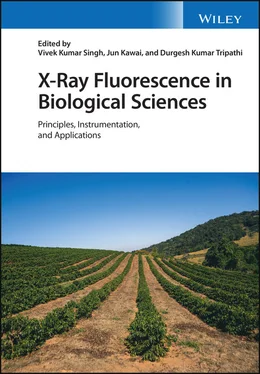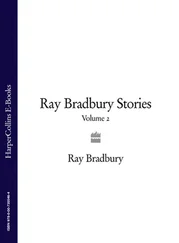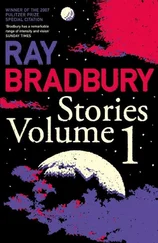X-Ray Fluorescence in Biological Sciences
Здесь есть возможность читать онлайн «X-Ray Fluorescence in Biological Sciences» — ознакомительный отрывок электронной книги совершенно бесплатно, а после прочтения отрывка купить полную версию. В некоторых случаях можно слушать аудио, скачать через торрент в формате fb2 и присутствует краткое содержание. Жанр: unrecognised, на английском языке. Описание произведения, (предисловие) а так же отзывы посетителей доступны на портале библиотеки ЛибКат.
- Название:X-Ray Fluorescence in Biological Sciences
- Автор:
- Жанр:
- Год:неизвестен
- ISBN:нет данных
- Рейтинг книги:5 / 5. Голосов: 1
-
Избранное:Добавить в избранное
- Отзывы:
-
Ваша оценка:
- 100
- 1
- 2
- 3
- 4
- 5
X-Ray Fluorescence in Biological Sciences: краткое содержание, описание и аннотация
Предлагаем к чтению аннотацию, описание, краткое содержание или предисловие (зависит от того, что написал сам автор книги «X-Ray Fluorescence in Biological Sciences»). Если вы не нашли необходимую информацию о книге — напишите в комментариях, мы постараемся отыскать её.
Discover a comprehensive exploration of X-ray fluorescence in chemical biology and the clinical and plant sciences X-Ray Fluorescence in Biological Sciences: Principles, Instrumentation, and Applications
X-Ray Fluorescence in Biological Sciences: Principles, Instrumentation, and Applications
X-Ray Fluorescence in Biological Sciences — читать онлайн ознакомительный отрывок
Ниже представлен текст книги, разбитый по страницам. Система сохранения места последней прочитанной страницы, позволяет с удобством читать онлайн бесплатно книгу «X-Ray Fluorescence in Biological Sciences», без необходимости каждый раз заново искать на чём Вы остановились. Поставьте закладку, и сможете в любой момент перейти на страницу, на которой закончили чтение.
Интервал:
Закладка:
Ninomiya [83] used TXRF to test the quality of instant coffee. A drop of 1 μl of coffee sample was pipetted onto the Si substrate, then dried and measured. Excitation conditions: 40 kV and 30 mA, Mo Kα radiation of X‐ray tube anode, sample measurement time – 1000 seconds. Spectra obtained during measurement of two samples of instant coffee showed the presence in the coffee spectrum of a doubtful quality of emission line P and Cl, while in the spectrum of ordinary coffee line P is absent, and a weak peak Cl is visible. The Si peak due to the use of the Si substrate was noted. According to the gas chromatography and inductively coupled plasma mass spectrometry method, the difference between the spectra for the two coffee samples is due to the presence in the coffee sample of a doubtful quality of dichlofos, containing P and Cl.
Akamine et al. [84] carried out XRF analyses for 102 samples of fried and green coffee beans from Brazil, Colombia, Guatemala, Indonesia, Tanzania, and Vietnam. The Epsilon 5 polarized ED spectrometer was used. In combination with a 100 kV high voltage generator, this spectrometer allows the determination of high Z element contents with better sensitivity. To build a calibration graph, CRM plants were used: tomato leaves (SRM 1573a), spinach leaves (SRM 1570a), apple leaves (SRM 1515), wheat flour (SRM 1567a), white rice flour (CRM 7502a), and rice flour‐unpolished (CRM No.10‐a). Preparation of the samples for analysis consisted of lyophilization, grinding, and pressing of the material. Authors investigated the effect of tablet thickness (0.5–4.5 g) on the fluorescence intensity of elements with high Z. It was found that the radiation intensities of the Kα‐lines of Rb and Sr increase with increasing tablet weight and become constant at 2.5 g weight (tablet thickness – 6 mm). When the fluorescence intensities were normalized to the intensity of non‐coherently scattered primary radiation, it is obtained that the intensities of the Kα‐lines Rb and Sr do not change practically at the weight of the sample of 1.5 g (thickness – 4 mm). The effect of the secondary target material on fluorescence intensity has been investigated. It was obtained that the optimum secondary target for Mn, Fe, Ni – Ge (sixty minutes), for Rb and Sr – Mo (three hundred seconds), for Ba – Al 2O 3(sixty minutes). The measurement time of one sample was two and a half hours. A fundamental parameter method was used to determine the concentration of elements. Detection limits were obtained in ppm: 0.4 for Mn, 0.4 for Fe, 0.4 for Ni, 0.2 for Rb, 0.2 for Sr, and 0.8 for Ba. Table 3.3shows the concentrations of elements in coffee zeroes by country of cultivation. The maximum levels of Mn (47 ppm), Sr (12 ppm), Ba (9 ppm) were recorded in coffee samples from Colombia, Fe (53 ppm), Ni (3 ppm) in Vietnamese coffee, Rb in coffee from Indonesia (82 ppm) and from Tanzania (67 ppm). It has been found that roasting does not affect the content of analytes in coffee. The use of analysis results for Fe, Mn, Ni, Rb, Sr, and Ba allowed for the successful identification coffee's country of origin.
Table 3.3 Concentrations (mean ± standard deviation) of some elements in coffee beans, depending on the country of origin (ppm) Adapted from [84].
| Element | Concentration (mean ± standard deviation) | |||||
|---|---|---|---|---|---|---|
| Mn | 39.7 ± 4.9 | 47.1 ± 8.5 | 29.3 ± 2.3 | 34.6 ± 20.1 | 37.5 ± 4.8 | 39.7 ± 10.1 |
| Fe | 35.5 ± 3.8 | 30.7 ± 1.4 | 52.9 ± 13.2 | 32.8 ± 3.5 | 28.3 ± 2.7 | 29.7 ± 1.5 |
| Ni | nd | 0.5 ± 0.3 (n = 10) | 3.5 ± 0.9 | nd | nd | nd |
| Rb | 22.2 ± 5.7 | 23.5 ± 7.4 | 42.7 ± 13.8 | 82.5 ± 13.4 | 67.2 ± 9.5 | 37.7 ± 7.7 |
| Sr | 3.4 ± 0.7 | 11.8 ± 8.3 | 3.3 ± 0.7 | 5.7 ± 1.1 | 6.4 ± 2.9 | 6.6 ± 1.8 |
| Ba | 3.1 ± 1.0 | 8.6 ± 3.8 | 2.3 ± 1.4 (n = 15) | 4.3 ± 2.8 | 7.7 ± 4.1 | 6.3 ± 2.3 |
| Number of samples (n) | 17 | 17 | 17 | 10 | 7 | 7 |
| Production country | Brazil | Colombia | Vietnam | Indonesia | Tanzania | Guatemala |
Note – nd: not detected; n: number of samples
Debastiani et al. [85] used the PIXE version to investigate the elemental composition of roasted coffee grains and roasted ground coffee. The chemical composition of the packaged roasted ground coffee and the composition of the similarly roasted coffee grains ground immediately prior to the analysis were also compared. Measurements were performed at the Institute of Physics of the Federal University of Rio Grandi do Sul (Brazil, Ion Implantation Laboratory). A beam of protons with an energy of 2 MeV and Si (Li) a detector with energy resolution of 160 eV for radiation with an energy of 5.9 keV were used. C, O, and N are measured by the Rutherford Backscatter (RBS) method. The results showed that the coffee grain matrix consisted mainly of C, followed by O and N. PIXE results for roasted ground coffee and roasted coffee grains showed that K and Mg are the elements with the highest concentration, Zn and Sr are trace elements. Comparison of these two types of coffee showed that the contents of certain elements, particularly Mg, Cl, Ca, Fe, Zn, and Rb, are statistically significantly different. No clear picture of the origin of such differences has been revealed. Because of this, the correlation between these differences and the quality of the final drink has not been established. The authors note the possibility that factors such as processing and negligent harvesting leading to the inclusion of twigs and defective beans in frying processes and crushing may have influenced the results. The results obtained by the authors for Cl showed that packaged ground roasted coffee contained more of this element, compared with fresh ground coffee. Cl‐based compounds such as chloroanisoles are known to impart unpleasant odors to beverages such as wine and coffee, and these results are consistent with the fact that freshly ground coffee is generally thought to produce a better‐quality beverage. Green and roasted grains have the same chemical composition, indicating that none of the elements studied in this work are lost during the roasting process. All elements except Fe have the same concentrations in both kinds of grains. The distribution of elements over the surface of the grains is uniform, while the distribution within the grains shows certain patterns for different elements.
In the work of Hernández et al. [86], an ED X‐ray spectrometer (Rh anode, silicon drift detector) was used to determine the contents of several elements from 11 to 38: Na, P, S, Cl, K, Ca, Mn, Fe, Cu, Zn, Br, Rb, and Sr. The sample material was dried at room temperature and the tablets were pelletized. The authors analyzed 11 samples of commercial ground coffee and compared the obtained data with a sample of instant coffee and two other samples of ground coffee. Calibration and validation of content determination accuracy was assessed by analyzing CRM‐certified NIST 1547 (peach leaves), 1570a (spinach leaves), 1573a (tomato leaves), and 1571 (orchid leaves). Generally, the measured content of the elements was little different for all coffee samples and did not exceed toxic levels. Nevertheless, differences between the contents of the elements are shown and discussed. The authors recommend collecting a more complete collection of coffee samples for future work. In such a collection it is necessary to significantly expand the range of samples for instant coffee.
In a recently published article Debastiani et al. [87] continued research on Brazilian coffee by PIXE version. The authors investigated the change in the chemical composition of Brazilian coffee at various stages of the drip brewing process. For this purpose, more than 140 samples of 8 different Brazilian brands of ground coffee (original samples of ground coffee, material of spent coffee, and coffee beverage after paper filtration) were analyzed. Major conclusions from Debastiani et al. [87] are:
Читать дальшеИнтервал:
Закладка:
Похожие книги на «X-Ray Fluorescence in Biological Sciences»
Представляем Вашему вниманию похожие книги на «X-Ray Fluorescence in Biological Sciences» списком для выбора. Мы отобрали схожую по названию и смыслу литературу в надежде предоставить читателям больше вариантов отыскать новые, интересные, ещё непрочитанные произведения.
Обсуждение, отзывы о книге «X-Ray Fluorescence in Biological Sciences» и просто собственные мнения читателей. Оставьте ваши комментарии, напишите, что Вы думаете о произведении, его смысле или главных героях. Укажите что конкретно понравилось, а что нет, и почему Вы так считаете.











